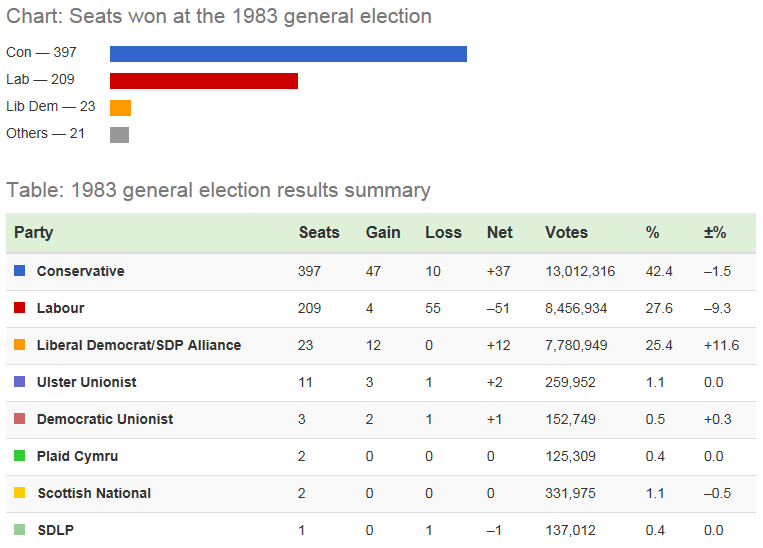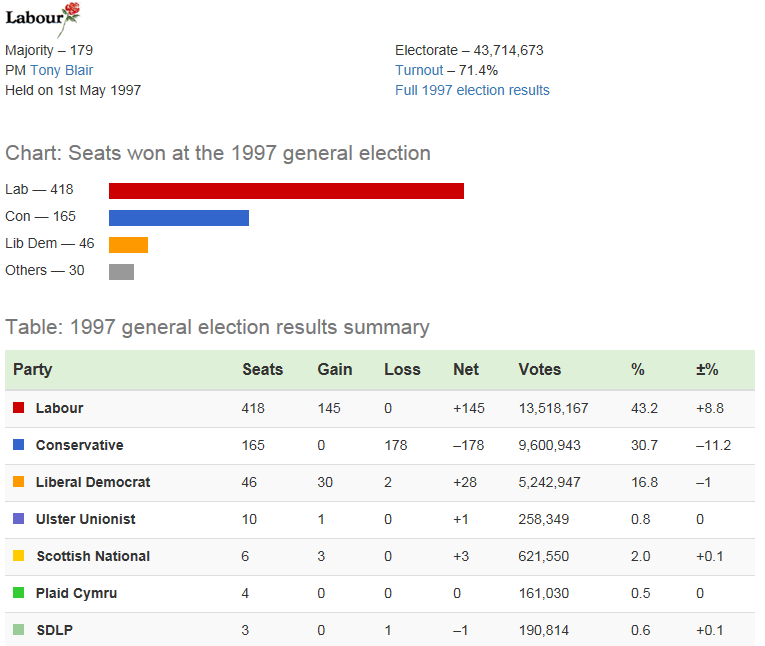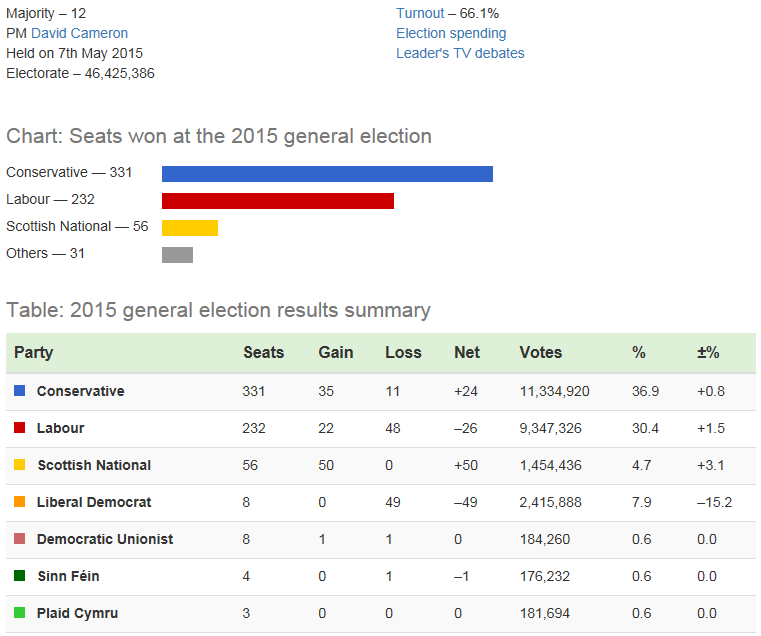Electoral System Case Studies
1983Election
Source: BBC News archive
“Margaret Thatcher’s second election victory in 1983 was one of the most decisive in post-war Britain. The Conservatives benefited from a three horse race, in which votes for the opposition were split between the Labour Party and the Liberal/SDP Alliance. Thatcher’ majority rose to 144 seats. In terms of share of the vote, Labour only just managed to come in ahead of the Alliance, in their worst election performance since 1918.”
Source: ukpolitical.info
Background and campaign: “The Conservatives entered the 1983 general election campaign in good shape. Although Margaret Thatcher was one of the most unpopular Prime Ministers in history during her first years in office, Britain’s victory in the Falklands conflict in 1982 radically improved her personal popularity and that of the Conservative Government. Labour, on the other hand, were weakened by internal divisions and defections to the new Social Democratic Party (SDP).
Michael Foot became the new leader of the opposition in 1980. The election of Foot as leader represented a dramatic swing to the left, and served to polarise divisions in an already divided party. In 1981, former Cabinet ministers Roy Jenkins, Shirley Williams, Bill Rogers and David Owen left the Labour Party to form the SDP. Jenkins soon entered into a pact with the Liberals, forming a new political unit known as The Alliance.
Buoyed by the victory over Argentina in The Falklands, as well as an improving economic situation for some sectors of the electorate, Mrs Thatcher decided to go to the polls. The May local election results, and favourable opinion polls, encouraged her in this decision. When she announced the election for 9 June, some opinion polls showed her running up to 18 points clear of Labour.
The Conservatives’ manifesto was formed around three pillars - defence, employment and economic prosperity. The Tories remained committed to membership of the European Community, an independent nuclear deterrent, trade union reform, further privatisation, a long-term reduction in taxation and a war on inflation.
The Labour manifesto was later dubbed “the longest suicide note in history”. It contained some extreme pledges including withdrawal from the Common Market, the abolition of the House of Lords, the cancellation of the Trident nuclear programme and the removal of Cruise missiles from Britain.
The Conservatives remained on top throughout the campaign. Thatcher’s media portrayal was very strong, whereas Foot’s was very negative. Foot was forced to modify the manifesto’s defence commitments, saying Labour would “move towards” a non-nuclear defence policy and the removal of nuclear bases. Meanwhile, the Alliance made few in-roads. Despite more television coverage than ever before the voters remained disinterested. With the polls about to close, the Tories looked likely to romp home by benefiting from the split in the opposition vote.”
Result: “The Conservatives won 397 seats, leaving Labour with 209 and the Alliance with 23. Although the Conservative share of the vote fell to 42.4% (from 43.9%), the government was returned with a landslide majority of 144. Labour saw their share of the vote fall to just 27.6% - only two points above the Alliance on 25.4%.
Nationally, there was a swing of 3.8% from Labour to the Conservatives. The most pronounced regional swings occurred in Southern England, where Labour won only two seats out of a possible 110.
The Conservatives had reaped the rewards of Labour’s divisions to win one of the largest majorities in post-war history, second only to Clement Attlee’s Labour majority in 1945. Margaret Thatcher was now firmly entrenched as Prime Minister with a majority that would ensure the passage of her increasingly radical agenda. The Labour Party was left badly wounded by defeat, and began the process of a comprehensive policy review which saw it move away from the 1983 manifesto policies.”
1997Election
Source: BBC News archive
“In 1997 Labour returned to power with a parliamentary landslide, winning the biggest majority held by any government since 1935- 179 seats. The election also saw the Liberal Democrats put in a strong performance, more than doubling their number of MPs despite taking a reduced share of the vote compared with 1992.”
Source: ukpolitical.info
Background and Campaign: “The Conservatives had taken a hit on their traditional reputation for economic competence. In September 1992 the pound spectacularly crashed out of the European Exchange Rate Mechanism. From this stage on Labour was ahead in the polls. In addition, there was open Conservative feuding on Europe and this was responsible for the government’s defeat on the Maastricht Bill in 1993 as well as for John Redwood’s 1995 leadership challenge. There were 12 Conservative resignations from office taking place over allegations of personal impropriety and misconduct, meaning the Conservatives were in a very weak position going into 1997.
For Labour, John Smith replaced Neil Kinnock as the leader, but died of a heart attack in May 1994 and was replaced by the shadow home secretary, Tony Blair. Under Blair, the “modernisation” process started by Neil Kinnock gathered momentum. Blair dropped the commitment to nationalisation set out in Clause IV of the Labour constitution and rebranded the party as New Labour. The polls briefly registered a Labour lead over the Tories’ of above 30%.
_John Major left it until the last possible minute before calling the 1997 election, in the hope that the “feel-good factor” that accompanies economic prosperity would turn around Tory fortunes in the polls, but it never did. _
_Left with little alternative, Major hoped a long campaign - six weeks, from 17 March to polling day on 1 May - would expose New Labour’s policies to scrutiny and see the party’s relatively inexperienced leadership crack under pressure. _
_But in the face of a professional, super-disciplined and highly cautious campaign by a Labour Party fearful of losing an election it was overwhelmingly expected to win, the Tory strategy had little impact. Labour had adopted campaigning techniques from the US, including a rapid rebuttal unit designed to ensure a swift and sure response to any Conservative attacks on the party. _
_The Conservatives struggled throughout. Things got so bad between Major and members of his own cabinet he was even caught on tape referring to several of them as “bastards”. _
But despite the Tories’ problems, by 1997 Major could point to a strong economy - and campaigned on the theme “Britain’s booming, don’t let Labour ruin it”. However, since the Tories had denied responsibility for the recession of the early 1990s, the voters did not give them credit for the subsequent recovery.
Even traditionally Tory-supporting newspapers deserted the Conservatives- the Sun newspaper backed Labour for the first time in decades.
As well as Conservative weaknesses, the result of the election was undoubtedly down to Tony Blair’s leadership. When he took over, the “modernisation” of the party was escalated to a degree not previously thought possible. The priority remained to strip away policies that he believed had lost the party the crucial support of the middle classes in 1992. He portrayed himself, successfully, as the strong and decisive leader of his party, setting a clear policy direction.
In addition, Lib Dem leader Paddy Ashdown - the oldest but perhaps most energetic of the main party leaders – had a strong personality - and a forthright style which impressed many voters.
Labour campaigned on promises not to raise income tax, to cut class sizes and reduce NHS waiting lists, which were designed to repel any Tory attacks on Labour as a ‘tax and spend’ party. Blair also made clear that education would be the government’s top priority.
The Tory manifesto kept the party’s options open on whether to join the single currency, but firmly rejected a federal Europe. It made pledges to privatise the London Underground as well as imagining a state were the State Earnings Related Pension was phased out - neither commitment was a vote winner.
Like Labour the Liberal Democrats put education at the top of their agenda. They promised £2bn would be pumped into the school system, while they also offered to restore fee eye and dental checks. Paddy Ashdown told the voters that the party would need an extra 1p on income tax if elected to fund these commitments.”
Results: “Labour won 418 seats, the most seats the party has ever held, and the highest proportion of seats held by any party in the post-war era. The election saw a huge 10.2% swing from the Conservatives to Labour on a national turnout of 71% and would be the last national vote where turnout exceeded 70% until the 2016 EU referendum was held nineteen years later. Blair was to be Prime Minister until his resignation in 2007. The New Labour project, having been shown to be electorally successful, continued until 2010 under Gordon Brown’s leadership, and the Conservatives were destined to spend 13 years out of government as the party struggled to modernise its image.”
2015Election
The Conservatives won a surprise outright majority, similar to their victory in the 1992 general election. Having governed in coalition with the Liberal Democrats since 2010, the party won 330 seats and 36.9% of the vote, this time winning a working majority of 12.
Source: ukpolitical.info
Background and campaign: Prior to the 2010 general election, the Labour Party and the Liberal Democrats pledged to introduce fixed-term elections. As part of the Conservative–Liberal Democrat coalition agreement, the coalition government agreed to support legislation for fixed-term Parliaments, with the date of the next general election being 7 May 2015. This resulted in the Fixed-term Parliaments Act 2011, which removed the prime minister’s power to advise the monarch to call an early election.
The campaign was dominated by the possibility (and expectancy) of a Hung Parliament. With the outgoing Government a coalition and opinion polls not showing a large or consistent lead for any one party, it was widely expected and predicted throughout the election campaign that no party would gain an overall majority, This was also associated with a rise in multi-party politics, with increased support for UKIP, the SNP and the Greens.
The question of what the different parties would do in the event of a hung result dominated much of the campaign. Smaller parties focused on the power this would bring them in negotiations; Labour and the Conservatives both insisted that they were working towards winning a majority government, while they were also reported to be preparing for the possibility of a second election in the year. Most predictions saw Labour as having more potential support in Parliament than the Conservatives, with several parties, notably the SNP, having committed to keeping out a Conservative government.
Conservative campaigning sought to highlight what they described as the dangers of a minority Labour administration supported by the SNP. This proved effective at dominating the agenda of the campaign and at motivating voters to support them. The Labour, Conservative and Liberal Democrat parties rejected the idea of a coalition with the SNP. This was particularly notable for Labour, to whom the SNP had previously offered support. SNP leader Nicola Sturgeon later confirmed that she was prepared to “help make Ed Miliband prime minister.”
The Liberal Democrats said that they would talk first to whichever party won the most seats. They later campaigned on being a stabilising influence should either the Conservatives or Labour fall short of a majority. On the question of finance and the economy, the budget deficit, who was responsible for it and plans to deal with it were a major theme of the campaign. While some smaller parties opposed austerity, the Conservatives, Labour, Liberal Democrats and UKIP all supported some further cuts, albeit to different extents.
Conservative campaigning tried to blame the deficit on the previous Labour government. Labour, in return, attempted to establish their fiscal responsibility. With the Conservatives also making several spending commitments (e.g. on the NHS), commentators talked of the two main parties’ “political cross-dressing”, each trying to campaign on the other’s traditional territory.
The first series of televised leaders’ debates in the United Kingdom was held in the previous election. After much debate and various proposals, a seven-way debate with the leaders of Labour, the Conservatives, Liberal Democrats, UKIP, Greens, SNP and Plaid Cymru was held with a series of other debates involving some of the parties.
Much of the media supported the parties they traditionally backed. A feature of the media campaign was a relentless negative focus on the competence of Labour leader Ed Miliband, who was portrayed as weak and not a potential Prime Minister. David Cameron, on the other hand, had a generally favourable media portrayal.
Results: Despite opinion polls suggesting that Labour and the Conservatives were neck-and-neck on vote share, the Conservatives surprisingly won a small overall majority. David Cameron became the first Prime Minister to continue in office immediately after a term of at least four years with a larger popular vote share since 1900, and the only Prime Minister other than Margaret Thatcher to continue in office immediately after a term of at least four years with a greater number of seats. Labour saw a small increase in its vote share to 30.4%, but incurred a net loss of seats to return 232 MPs. This was its lowest seat tally since the 1987 election.
The Scottish National Party, enjoying a surge in support since the 2014 Scottish independence referendum, recorded a number of huge swings of over 30% (including a record-breaking swing of 39.3% achieved in Glasgow North East) from Labour, as it won 56 of the 59 Scottish seats to become the third-largest party in the Commons. The Liberal Democrats had their worst result since being formed in 1988, holding just eight out of their previous 57 seats with cabinet ministers Vince Cable, Ed Davey and Danny Alexander losing their seats. UKIP came third in terms of votes with 12.6%, but only won one seat, with party leader Nigel Farage failing to win the seat of South Thanet. The Green Party won its highest-ever share of the vote with 3.8%, and held Brighton Pavilion with an increased majority, though did not win any additional seats. Miliband resigned, as did Clegg. Farage claimed that his resignation was rejected by his party, and he remained in post.
- Which party arguably helped to split the Labour vote in 1983?
- Your answer should include: Liberal / SDP
- Who was Labour leader in 1983?
- Your answer should include: Michael / Foot
- Which event had helped boost Thatcher’s popularity prior to 1983?
- Your answer should include: Falklands / War
- What was Labour’s 1983 manifesto nicknamed?
- Your answer should include: Longest / Suicide / Note
- Who had Tony Blair taken over as Labour leader from prior to 1997?
- Your answer should include: John / Smith
- What were the Conservatives arguing over throughout the 1992-1997 Parliament?
- Europe
- How large was the Labour majority in 1997?
- Your answer should include: 179 / Seats
- What was the turnout for the 2015 election?
- 66%
- How big a majority did the Conservatives end up winning in 2015?
- Your answer should include: 12 / Seats
- Which three leaders resigned following the 2015 result (although one of them promptly ‘un-resigned’)?
- Your answer should include: Miliband / Clegg / Farage


